Context
This project aims at removing uncertainties regarding the wood-energy potential in Belgium and to know the impact of its utilization on its emissions of greenhouse gases, on other environmental components and on the economy.Furthermore, it takes down and classifies the data allowing to assess the political consequences of the wood-energy market development.
Objectives
- to draw up an inventory including : the Belgian wood-energy resources, the wood-energy utilization techniques, the Belgian potential demands in wood-energy ;- to propose an evaluation tool allowing to define better the political options of the wood-energy process development ;
- to analyse the wood-energy development ;
- to contribute to the definition of the middle and long term objectives, concerning the emissions of greenhouse effect gases, to take part in the assessment of equipment and measurements allowing to reduce the emissions of greenhouse effect gases in Belgium and to propose some political, technical and economical options, in order to develop the wood-energy process in Belgium.
Description of tasks
To quantify and classify the wood-energy deposits- drawing up of an inventory of all the wood-energy sources in Belgium (except for wood crop) ;
- qualitative and quantitative sorting of the wood-energy deposit, so as to bring out the sources presenting an interest as fuel.
To take down and classify the wood-energy mobilization techniques
This part is devoted to the wood conditioning, that is :
- collection (inventory of the harvesting techniques and costs according to the different wood sources) ;
- transporting from the collection place to the stocking place (inventory of techniques and costs) ;
- chipping (inventory of techniques and costs) ;
- potential drying (inventory of techniques and costs).
To take down and classify the wood-energy potential demands
the CRA draws up a list of the actual or potential users (type, numbers, specific requirements …) ;
this list will complete the general inventory of the project and will allow the socio-economic and environmental assessment, which is the phase 2 of the project.
Results obtained
The project carries out the inventory of wood residues in Belgium (forest residues, sawmills, workshops, building, construction and demolition enterprises). Furthermore, the availability and price of these residues are assessed.The mobilization and conditioning means of wood residues are assessed and put together according to processes. To these processes are added production costs and a cost per ton of fuel produced.
At last, the current demand and potential in wood energy is studied.
As an example, in 1998, almost 20 % of the sawing, veneering-making and cutting enterprises had difficulties clearing their by-products. Among those, barks hardly found buyers while sawdust and chips were generally sold to pulp and particle board industries. If the use of by-products to produce energy remains marginal, it however interests more than 40 % of the enterprises questioned for this enquiry.
All the members of the Sawmill National Federation use annually 1269801 m³ of logs. These same members produce each year 648375 m³ of manufactured wood. If we extrapolate these data to Belgian sawyers, we can assess the annual consumption of logs to 1587251 m³/year and the sawn wood to 810468 m³/year. These sawings include approximately 35 % of leaved trees and 65 % of resiniferous trees.
About 50 % of the enterprises questioned produce barks ; there is however an important variation according to the species used. We can assess that within the Sawmill National Federation, 45 enterprises produce annually 80707 tons of barks. Extrapolated to Belgian sawyers, these data make it possible to assess their bark production to 94019 tons/year. These barks are mainly stored in containers and sold to be composted.
Among the enterprises questioned, 69 % of those using resiniferous species and 33 % of those using leaved trees species produce chips. 40 members of the Sawing National Federation produce annually 395396 tons of chips. That is for Belgian sawyers, a production assessed to 446807 tons/year.
These chips are stored on concrete screeds or in containers and are almost exclusively sold to pulp or particle board industries.
27 % of the enterprises using resiniferous species and 58 % of those using leaved trees produce offcuts. We can assess that 48 members of the Sawmill National Federation produce annually 43750 tons of offcuts. Belgian sawyers would therefore produce 54688 tons per year. These offcuts are mainly stored as tied up bundle and are usually sold to board industries.
The members of the Sawmill National Federation are 94 to produce annually 141193 tons of sawdust. That is 166303 tons per year for Belgian sawyers. They are mainly stored in silo and meant to be sold to particle board industries.
About 35 % of the enterprises questioned produce wood chips (16942 tons/year for the members of the Federation and 21178 tons/year for Belgian sawyers), without any real distinction between users of leaved or resiniferous species. Chips are mainly stored in containers before being sold most often to particle board industries.
Partners
UCL- TERM Unit - Biology Department - ECOP Laboratory, Enterprise Environment Centre IAG, University of AnversCRAW off coordinator
UCL-TERMPlace du Levant 2
1348 Louvain-la-Neuve
Funding
- Federal Scientific Policy

